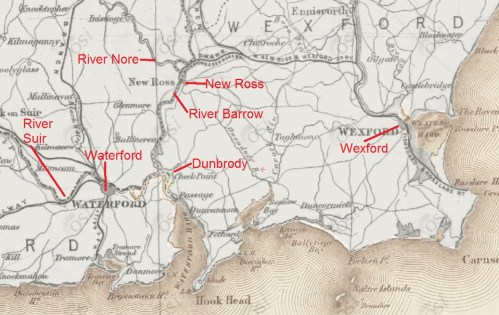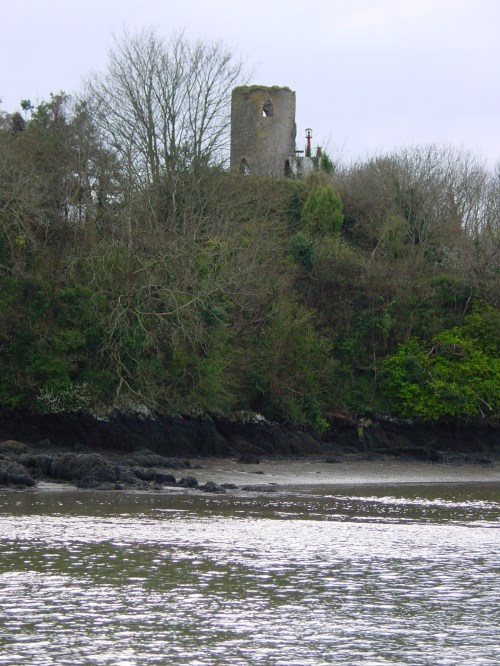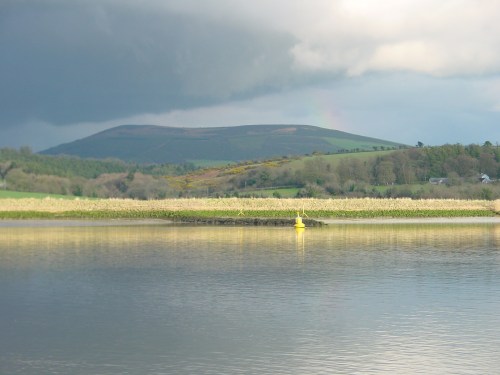This account is from J G Kohl Ireland. Dublin, the Shannon, Limerick, Cork, and the Kilkenny Races, the round towers, the lakes of Killarney, the county of Wicklow, O’Connell and the Repeal Association, Belfast and the Giants Causeway Harper & Brothers, New-York 1844; several versions are available online.
The author, touring Ireland in 1842, has spent the night in Waterford and is to travel to New Ross en route to Wexford.
When I came to the river-side, on the following morning, it was low water. Several vessels were lying on their broadsides in the mud, and above the beautiful bridge of Waterford almost all the water seemed to have run out of the Suir. As the tide rose, however, the sandbanks and the mud were covered, the ships floated again, the landscape was again reflected in its watery mirror, and our steamer was able to rush forth on her noisy path. This steamer was called the Repealer, and being patronized by all the repealers was, sometimes, called the People’s Steamer. On the flag was inscribed, “Hurrah for the Repeal of the Union!” O’Connell may therefore boast at his meetings that the cause of repeal is now progressing by steam. Not that upon this occasion it could be said to go far, for the steamer was only bound to New Ross, and an opposition boat was panting and splashing along by the side of ours.
If I had not sailed down the Firth of Clyde, I should have been ready to admit this trip along the arms of Waterford harbour to be one of the finest in the United Kingdom. The waters flow through the deep and convenient bays more rapidly than through a lake, yet as the projecting hills completely conceal the sea, the traveller is tempted to believe himself on a lake, and looks with wonder at the mighty vessels ascending the river towards Waterford. Sometimes the banks rise into gentle elevations, studded with country-seats and parks, at other times they rise abruptly into lofty rocks crowned with trees.
Not far below Waterford are seen the extensive ruins of Dunbrody Abbey, among the most celebrated ruins of all Ireland, where they hold nearly the same rank as those of Melrose do in Scotland. They lay far from our view, like the days of Dunbrody’s greatness, and the Repealer, with the opposition boat treading on her heels, had no time to stop and contemplate picturesque objects. To be sure it was not long before we had the pleasure of seeing the oppositionist run herself aground on a sandbank, where, our captain drily remarked, she must lie till the tide raised her; nevertheless the Repealer could not afford to be behind her time at New Ross, so we turned our back upon Dunbrody and began to ascend the stream of the beautiful Barrow.
On board of an Irish steamer entertainment is seldom wanting. Even on the quarter-deck there is twice as much conversation as on board of an English steamer, and on the forecastle we had not only music but also dancing. Paddy, to whom an old door suffices for the flooring of a ball-room, finds it, of course, difficult to resist the temptation of a spacious deck, on which some room remains, in spite of all the butter-casks, meal-sacks, and hencoops, to say nothing of pigs and cattle. He lays his stick and his sorrows aside, and, with a merrier face than the man of five thousand a year can generally boast of, snatches the hand of some half-resisting girl, and, in a joyous jig or reel, shakes his rags as briskly as though they were the jingling lappets of a motley garb. The paddle-wheels beat time to the dance, and the lovely banks of the Barrow enclose the spectacle with a decoration such as the stars of the ballet might sigh for in vain at Drury Lane or the Opera.
Beautiful seats belonging to the families of Power, Asmond, and others, lay scattered along the banks; and near Castle Ennis, in a large open meadow, I saw one of the finest, largest, and most picturesque oaks I had ever seen in my life. It was doubly interesting to me to look upon these chateaux, for I had by my side an Irish priest who was sketching to me the histories of the several families that resided in them. In one, he told me, lived an old lady, the widow of a distinguished rebel, who was beheaded during the last great rebellion.
In passing a rock we fired off our guns in compliment to the memory of a sailor, who, some months previously, had fallen overboard there, and been drowned. The sound was echoed back from the rocks, and the manes of the deceased, I have no doubt, were highly gratified by the honour shown them.
At New Ross we anchored, and, as this point is esteemed the most beautiful along the whole Barrow navigation, it would have been well worth while to have halted there, if only to view the upper banks of the Barrow, which are said to surpass the lower ones in beauty, but my travelling companion wished to avail himself of the fine night, and accordingly, at eleven o’clock, we started in a jaunting-car for Wexford, a distance of about twenty miles.
D B McNeill, in his Irish Passenger Steamship Services Vol II South of Ireland [David & Charles, Newton Abbot 1971], says:
[…] there was […] a lively river trade between Waterford and the towns on the Suir and the Nore [surely Barrow?], a trade which lasted from the 1830s until the opening of the railways to New Ross and Rosslare in 1904 and 1906 respectively. Throughout these seventy years steamers left Duncannon and New Ross on weekday mornings and returned from Waterford in the afternoon. The deck fare from either place to Waterford was 6d and the cabin fare 1s.
He says that the services were initiated by PS Shamrock (Waterford–New Ross) and PS Duncannon (Waterford–Duncannon; built by Lairds of Birkenhead) in 1837:
The Shamrock spent most of her time on the New Ross run. At one time in the mid-1840s she had the Cork harbour steamer Maid of Erin as a running mate and a vessel called the Repealer as a rival. The latter retired after a few months.
More on the tidal Barrow here and the Suir above Waterford here.
oiwb30








LOVELY THANK YOU SO MUCH FOR VIVID PICTURES OF THAT LIFE. iT DOES COME ALIVE ON THE PAGE.
Pingback: Waterford harbours lost souls – Tides ‘n’ Tales
Pingback: Waterford to New Ross by paddle steamer 1842 – Tides ‘n’ Tales